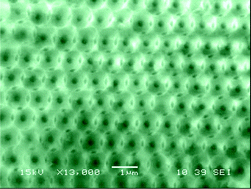Template assisted assembly of cobalt nanobowl arrays
Abstract
3-D interconnected networks of magnetic cobalt nanobowls with a wall size of <100 nm dimension have been fabricated. A novel technique was used to overcome the problem of volume shrinkage usually observed in such structures when formed by chemical conversion route. Cobalt particles were formed in the interstitial spaces of 3-D closed packed polystyrene (


 Please wait while we load your content...
Please wait while we load your content...